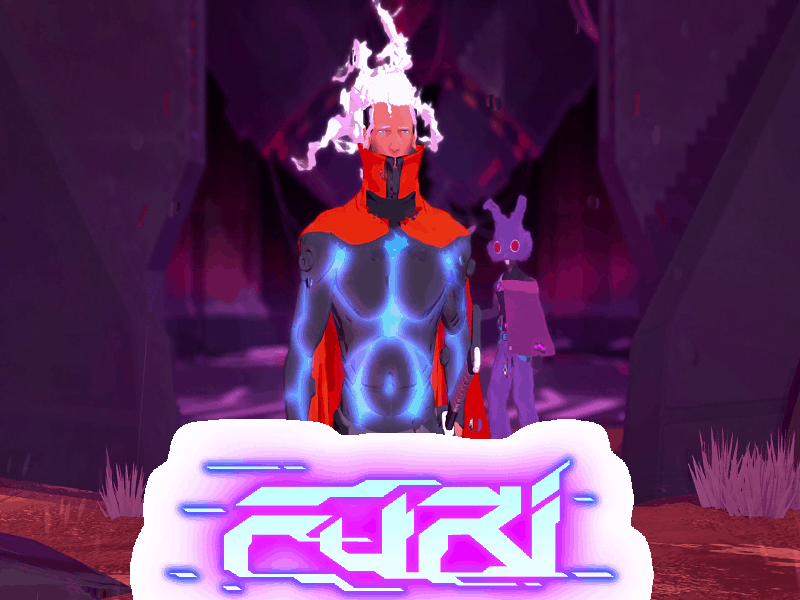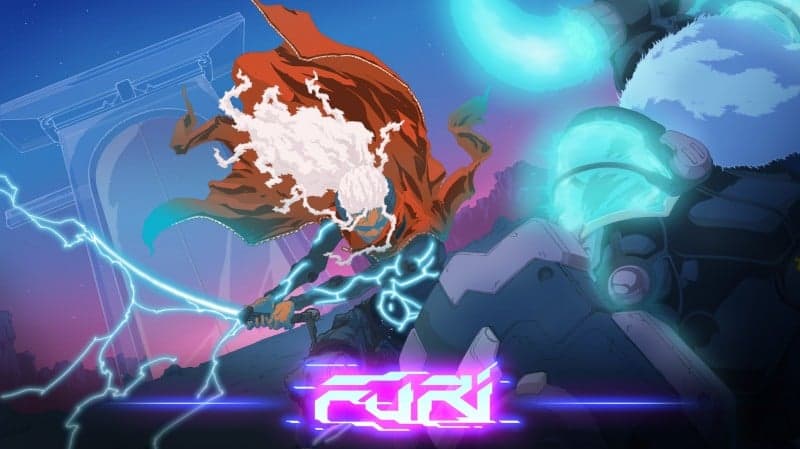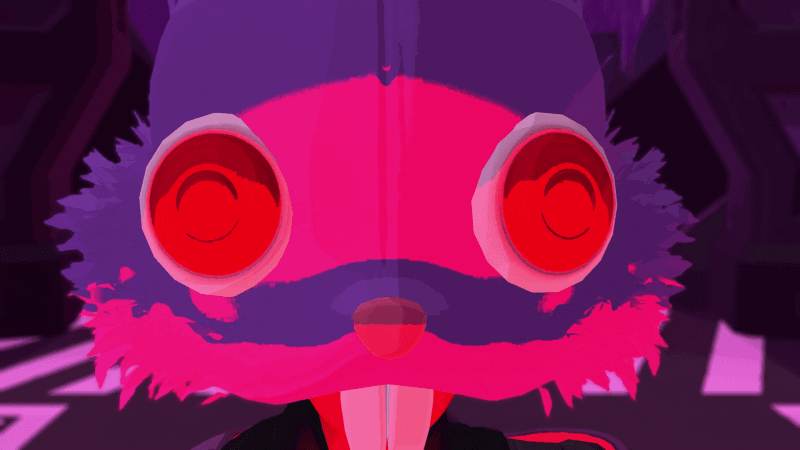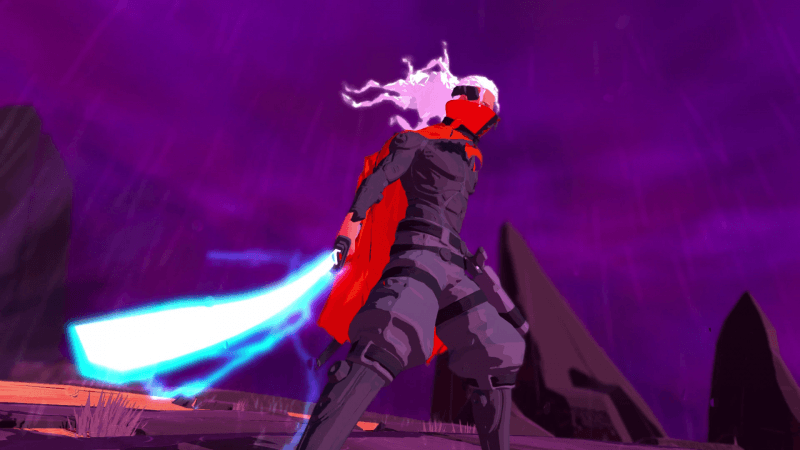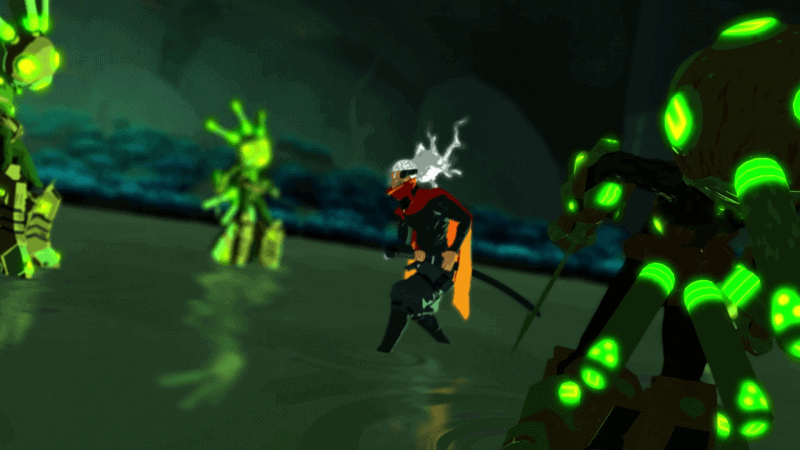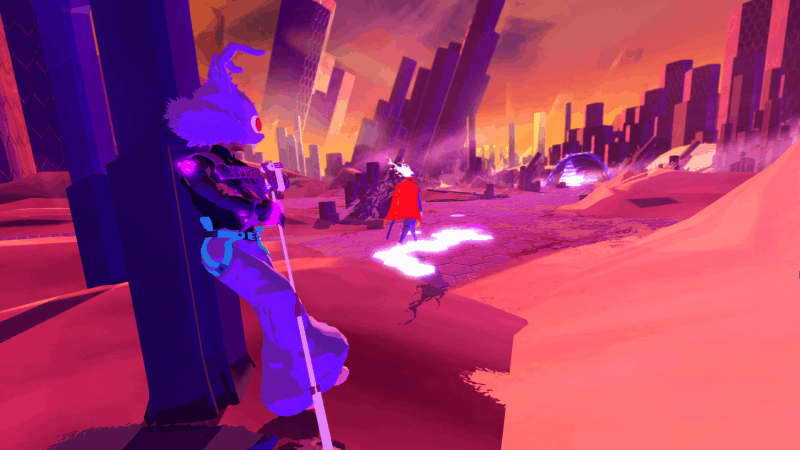The critically acclaimed game Furi (The Game Bakers, $19.99) has finally reached the Nintendo Switch! But of course, with ports, come questions. How well does it perform on the hardware? Are there new issues that didn’t exist before? Does it look as good? Are there new features or content? Well, dear reader, I’ll touch on that and so much more in this review. Follow me this way.
This is a description of the game for those unfamiliar with Furi:
‘Furi is all about the tension of one-on-one fights against imposing opponents over a mysterious quest for freedom. Praised for its unique mix of sword fighting and twin-stick shooting, Furi has been called “supremely stylish and intensely engaging” (GamesRadar) and “tight and empowering” (Games™), and has garnered 92% in positive user reviews on Steam.
With its stylish aesthetic and unique character design – by Takashi Okazaki, Afro Samurai’s creator – and its killer soundtrack featuring popular electro musicians Carpenter Brut, Danger and more, the game is a love letter to Japanese action games such as No More Heroes, Metal Gear Solid, and Godhand.
“Furi is a game that’s constantly taunting you,” comments Emeric Thoa, the game’s Creative Director. “There is something deeply personal about a boss fight: it’s just you against one opponent. And being interrupted is even more frustrating than losing. But with the Switch, you can take the game and all of its boss fights with you wherever you go.”’
And here is the classy announcement trailer for the Switch release:
Audio & Soundtrack:
Let’s start with the voiceovers this time, as I don’t really ever talk about them in titles. Furi definitely has voiceovers in game and I love them. I think that what you’ll notice upon playing this game is that there are voiceovers from the Rabbit looking fellow at the beginning of every boss. The first boss if part of your personal story, so he doesn’t talk as long as some other bosses by filling you in on their backstory. Some of the bosses talk at you as well in between fighting with you. But nonetheless, the voiceover actors in this game sound like that of a 2000’s dubbed anime. And who knows, that may be the end goal. Or maybe the actors that they chose are just so used to speaking with those tones and cadences that it just came out of them naturally that way. Either way, it is probably the most perfect fit for a game with these stylings and gameplay.
I also love that the talking doesn’t happen during the fighting itself. Maybe the boss says a sentence between changing his forms, maybe he says something before fighting. In any of those instances, I love that I’m not hearing them taunting me the whole time that they’re fighting me. The sheer amount of time that you spend fighting any given boss is frankly ungodly and if I would’ve had to have heard them talking and talking and talking, I would’ve walked away from the game after the second boss. Good job on The Game Bakers for finding a nice balance of gameplay and talking.
In terms of the sound effects all around, I think that they’re very balanced. You can’t tell if a lighting bolt sound is wrong or anything. It’s mastered very well to be sort of in the background where you’d expect sounds like that to be. Shooting your long distance weapon isn’t loud as heck coming out of your character as some games get wrong. This game is all really about you and your competitor and any distractions at all would be detrimental to the gameplay. No, if there are any shortcuts that they took when it comes to sounds, it just isn’t noticeable in any respect. The game didn’t leave me wanting in this department.
The soundtrack was dope as hell, by the way. I loved that this game uses different music for each boss and different music for the menus. When playing games like this you can always remember which boss gave you the most grief as you remember their song the best. Since all of the songs are different and not on some continuous game long loop, it is actually harder for me to review it. Yes, some songs were less thrilling than others. Some of them I didn’t feel fit the scenario. What I guess I could say overall is that in most cases, the gameplay was more overwhelming and kept my mind on that rather than obsessing over the music. And that might be the best case scenario here. But that is also a bummer for video game music aficionados. I will say that if you love this game after buying it, go buy the soundtrack off of the internet and you can really hone in on it and it too is worth every penny. 9/10
Visuals:
This game has a lot of PS2-era qualities about it. The music scores are nice and electronic in nature. The voiceovers, as mentioned, are very 2000’s overall. The visuals here are no different. If you’re looking at the pictures in this review as well as the trailer above, you may notice an on-going theme here. There is a heavy use of darks and lights, shadows if you will. This is something that is pretty much evocative of the PS2/Gamecube/XBOX generation of titles. Not all titles, mind you, but a fair amount of them. You’d see this styling in The Legend of Zelda: Wind Waker, Killer 7, or Jet Set Radio Future. Sometimes you’d see cell shading with bold, black outlines, but most of the time you wouldn’t unless it was trying to be a comic book (XIII, PS2).
So yeah, this game falls into that feeling that I used to get popping in a disc back in the day and watching the visuals show up on the screen. The smile on my face when playing this game just couldn’t be measured as my formative years were full of cell-shading. That’s why, on the Switch, this game looks delicious even when you’re playing undocked in 720p. I just can’t geek out enough over how beautiful it looks and it does so without having to look hyper-realistic or have 5.1 surround sound audio to distract you from the game looking bad. No, this game looks great and does so with no additional frills. What you see is what you get and that is what I’m happiest most about.
I would say the most caddywhompus part of this game is in between the fights. As the Rabbit dude is talking to you and you’re on your way to the next fight, you’re forced to walk. Cinematically the camera angle changes on you constantly. This does yield for some strange changing of the direction that you’re walking out of nowhere. Yes, you can actually keep pushing the direction you were pushing and not let go of the thumbstick and the game will keep your previous trajectory. However, the inner gamer in you won’t let you do this and you instinctively let go of the thumbstick and readjust, for your own sanity. I’m surprised that this Switch version still does this. I thought for certain that they would fix some stuff upon porting the game to a new system. 9/10
Gameplay:
This is the section that will be the most difficult for me as the reviewer. I suppose I can explain why in just a moment. Let me first start by explaining this game and how it works. When you first boot up the game, you’re given a choice of difficulty. I speak more about this down in the “Replay-ability & Longevity” section. For now, just know that I chose the standard difficulty. The game starts and, without giving too much away, you learn that you’re a prisoner and must beat a series of some bad people to escape. You’re released by the Rabbit man and he instructs you to take on your first adversary and that’s the game. You continue on from boss and location to the next boss and location. The Rabbit bro giving you the backstory of the next bad man on the way. So now you have the formula. It’s exclusively a game made up of boss fights with a couple minute interval between each one. If you’re wondering, there are 10 bosses in total.
The reason that it is difficult for me as the reviewer is simply for the fact that I find it hard to review since the game is only boss fights. I can’t possibly sit here and talk about all 10 of them to you, we’d be here all day. Some of them royally suck and some of them have better tells to catch onto than others. It’s sort of a crapshoot of bosses if you ask me. To clarify, I mean that they all seem like maybe they would be from different games. One from a Metroid game, one might be from Metal Gear Solid, one could be from a Spider-Man game. And I don’t necessarily mean that games exactly, I’m just giving examples that maybe the team drew inspirations from bosses of different games. This can be both a good and bad thing depending on how you do with different game types.
What I can do here is talk about the different types of abilities that you have as the protagonist and what tools and weapons that the antagonists have. So this game is sort of a mashup of a twin-stick shooter with a hack and slash. You can shoot freely or have a charged shot when the game allows you to shoot. The same goes with the katana that you have. In the parts of the fights where the game only lets you use your sword you can slash, charge slash, and parry. No matter if you’re up close or far away, you have a dodge function at your disposal as well. A lot of the bosses have a short range and long range attack just like you do. I would actually say that the bosses themselves aren’t that hard in the game. It’s more so the difficulty comes from how imbalanced your health is to the bosses’ health. They have like 5+ health bars in a round and you have 3. Your goal is more so either killing them first and dodging their attacks. Or getting hit by their attacks, collecting health that they drop enough to stay alive so that you can slowly chip away at theirs.
The differences between their fighting styles, tells, scenery and story are enough to stick with how extremely difficult this game is. And when I say difficult, I really truly mean it. If you suck at shooters and hack and slashes or just boss fights in general, this game isn’t for you. This game is for those who actually like a challenge. It’s for those who only really ever strive to reach the boss fights and overall want that feeling of accomplishment after beating something that is just too damn difficult. 8/10
Replay-ability & Longevity:
This game from the get-go has a few different difficulty options available to you as the player. You’ll see Promenade, Furi, Furier, and Speedrun Mode. Promenade is the easiest way to play the game. If you choose this option, you can get through the game pretty easily. The caveat to playing this mode is that it does not unlock Furier or Speedrun Mode after beating it. It is exclusively reserved as a way to play the game so that you may learn the game and some of the bosses tells. Then after you beat that you can move up to Furi mode. After completing that you can unlock Furier and Speedrun Mode respectively. The game actually gives you warnings about choosing Promenade. Telling you that you can’t unlock other modes with it and once you start it you can’t change it. It also tells you that the game is shorter than Furi Mode. On the other platforms, this hits even harder as it tells you that you can’t unlock trophies whilst in that mode.
I’m telling you all of this because these modes are the only thing that makes the game any longer. You’ll find that the difficulties themselves are also crazy unbalanced. You can beat all of Promenade in an hour to an hour and a half. It might take you that long to beat the first boss in Furi Mode. It’s sort of up to you if you just want to play the game through once in just Furi mode and then leave the game alone. Maybe you don’t need to get any more longevity out of this title. It is hard enough in Furi mode to make you mad even after you’re done playing it! That would pretty much be my suggestion. Normally I’d tell you to work your way from the bottom to the most difficult setting. In this game there is no in between difficulties, it just jumps so much in between each.
What I would say would actually make the game the longest and most worthwhile is the Speedrun Mode. If you liked the game and thought it was the right amount of challenge after beating it on Furi mode, just skip Furier mode altogether. Speedrun Mode gives you the ability to choose which boss that you want to play against in hopes of beating your previous rank. It just is endless fun and you don’t feel like you’re playing the same boss over and over if you can’t beat them. You have the choice, you make the decision of the boss, and maybe one day you’ll have an S rank on all of them. If this game didn’t have a Speedrun Mode, I wouldn’t be giving as high of a score in this section. There’s plenty of longevity in the game, I can admit that. There’s like 10 bosses, each crazier than the last. But, there just isn’t enough replay-ability here without Speedrun Mode. 7/10
Switch Impressions:
Every single game that has been ported to the Switch that I’ve reviewed thus far, I’ve played exclusively undocked. I always want to see what kind of graphics, audio, and gameplay that it brings to the table. I do this ordinarily because I’ve already played a PS4 or XBOX One version of these games in the past and already know what kind of an experience that I will get with the game if I play it docked. What I’m looking for is any signs of the visuals being changed, maybe the audio becomes muddy, or maybe the controls are just better suited to the Switch Pro Controller over the Joy-Cons. Why am I mentioning all of this you may wonder. Well, I thought it made more sense this go around to be more transparent about my Switch process. This section of the review is probably the one that is going to matter the most to anyone who has already played this game on other platforms. They want to know if it is worth buying again to play on the go or should it be left to those who are playing it for the first time.
I would actually say that it depends, given my results with the title. I’ll come back to that in a moment, let’s first look at what my results actually were. In my playing of the game, I found that undocked, it looked extraordinary. The visuals, as mentioned before, flowed effortlessly. There was no chop or any noticeable dropped frames at all while playing. It moves in and out of cutscenes and fighting effortlessly. And the audio keeps up right there with it. The depth of the audio can also receive an applause from the audience because whether you’re at half volume or full blast, you’re in for a treat. The gameplay feels great on the Switch, I never thought that holding up the considerably heavy Switch while fighting a boss for a very, very long time would be something that I would care to do. But the game is just so great with the controls and so ergonomic in terms of what buttons you’re using. It easily leaves the rest of your hands to hold up the system and your wrists can back them up comfortably.
So, why would I say that it would depend if it’s worth buying this game again? Here, let me expand on that. What I simply mean is that it probably depends on you as a gamer (and your wallet) considering the game is pretty flawless. Are you a gamer who rebuys everything on the Switch that you love? You can take it on the go with you, you’re not bound to a TV that everyone shares, so maybe it is a good idea? Or are you a gamer that you see that it’s just the exact same game that you’ve already paid for and beaten and thus want to leave it alone? I would love to tell you that this version far surpasses and adds more to the game than the other versions you may have already played. It does not, unfortunately, seem to do that, so that makes your decision harder. On the other side of that coin, being on the Switch does not detract from the game at all either, otherwise, if it were lesser you’d have your decision made for you. My statement would be that if you’re a gamer who is in love with this game and want to have the boss battling on the go, you should 100% buy it. If you’re new to the game and have never heard of it or never bought it on another platform, definitely buy it. The Switch version will treat you right. 10/10
Here is the link for the game download.
Stay tuned here on Hackinformer.com for more reviews and follow us on Twitter @Hackinformer
If you like the author’s work follow him on Twitter @V1RACY

